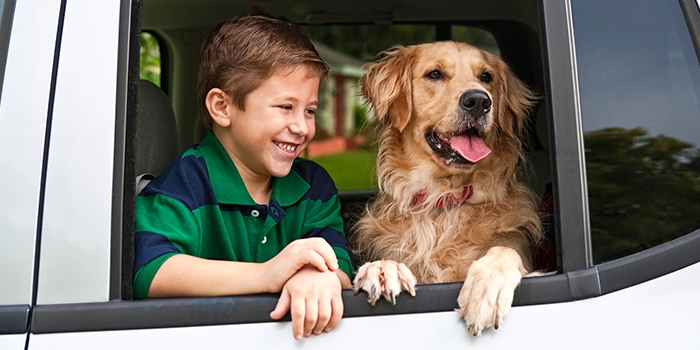Moving Long Distance With Pets: 8 Essential Tips


Moving with pets is complicated — and it’s even more complicated when you’re moving pets across the country. From transferring vet records to keeping your furry companions safe in transit, there’s a lot to plan for when moving long distance with pets. We’ve compiled some tips on how to move pets across country safely and get them successfully settled in their new surroundings.
If you’re moving to a new region or state, you’ll need to find a new vet for your pet. Before the move, research vets in your new location to figure out where you’d like to take your pet for care. Then, contact your current vet to figure out the best method of transferring vet records to your new vet. It’s likely your current vet will forward the medical records to the new place. That allows you to set up a consultation appointment quickly after the move so you can get proper vaccination tags for your new city and prescription refills, if necessary. Plus, your pet will be established with your new vet in the event of an emergency.
Moving day(s) can be stressful for your dog or cat, especially if you’ve hired movers. (Check out our packing faux pas.) Your pet might be upset about strangers entering your home and may be tempted to dash out an open door. Find a secure room for your buddy to get comfortable or place the pet in a comfortable crate during moving hours. For other packing tips, check out our packing checklist.
Moving with dogs or cats increases the possibility that they may run off. After all, your pets may experience high levels of stress when they’re exposed to new surroundings. If you and your pet become separated during travel or in your new neighborhood, proper identification with your current cellphone number can increase the likelihood that your pet will be returned safely. If your pet is microchipped, update the contact information on the chip before the move. For extra peace of mind, outfit your pet with a GPS tracker and alert system.
One of the biggest challenges when you’re moving out of state with cats or dogs is keeping them calm and comfortable in the car, which is critical to keeping you and your family safe on the road. If you know your pet gets carsick or anxious on the road, talk to your vet in advance about ways to reduce stress and discomfort. Secure your cat in a comfortable carrier you’ve acclimated the pet to in advance to help your cat stay calm. Dogs might prefer a dedicated travel safety harness that works with a car seat belt.
Your pet will need to eat, hydrate and use the bathroom. Some pets may also need to burn energy by taking a walk. Planning ahead will make the trip easier for you and your pet. Before the move, identify locations along the way where you can stop for breaks and walks. Likewise, if you need to stay overnight at a hotel, make a reservation at a pet-friendly hotel before you leave. Remember: Keep your pup on leash at all times and have a litter box available for your kitty.
Put a small bag together with your animal’s important items, like food, treats, water, medications, grooming gear, pet wipes, first-aid supplies and a toy or two. Pack extra items just in case your trip takes longer than anticipated.
Upon arrival, set up a spot for your pet that’s secure and comfortable. Include your pet’s familiar water bowl, pet bed and favorite toy. Even though moving can be exhausting and stressful for you, take a few minutes to get on the floor and play, scratch those ears or rub that belly. After all, home for your pet is wherever you are.
Take stock of your new abode and make sure it’s safe for your four-legged family member. If you have a fence, check for gaps or loose boards so your pet can’t get out and other animals can’t get in. Also check your yard for poisonous plants that need to be removed.
If you need to update your property insurance, your Farm Bureau agent will be happy to answer any questions. Happy trails and wagging tails!